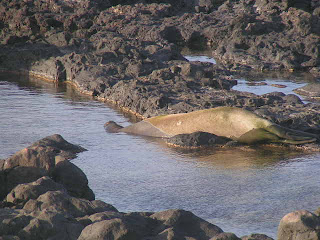What's Happening in Hawaii
during the 4th week in February:
Newly hatched Laysan albatross chick at Kaena Point NAR, O'ahu
Chicks of the Laysan albatross (Diomedea immutabilis), known to the Hawaiians as mōlī or ka'upu, are starting to hatch.
Above: A juvenile Laysan albatross at Kaena Point NAR, O'ahu
A mōlī begins to call even before its shell is cracked, and its parents respond, establishing a dialogue that lasts until the chick emerges, as much as six days later. Most nesting occurs on the remote northwest islands, but there is a large nesting colony at Ka'ena Point on Oahu.
Full-grown members of this handsome and powerful species have a wingspan of more than six feet and sometimes can be seen in flight off O'ahu and other main islands. But the search for squid, their primary food, commonly carries them hundreds of miles out to sea.
Noting its keen attention to life under the sea, Hawaiians took the albatross as a metaphor, calling an especially observant person ka manu ka'upu hālō ale o ka moana - "the ka'upu, the bird that observes the ocean."
Visit the Comprehansive Wildlife Conservation Strategy fact sheet here to learn more about the Laysan albatross.
The above information comes from "Hawaii: A Calendar of Natural Events"
Published by Bishop Museum and Kamehameha Schools in 1989
All photos by C. Tucker













